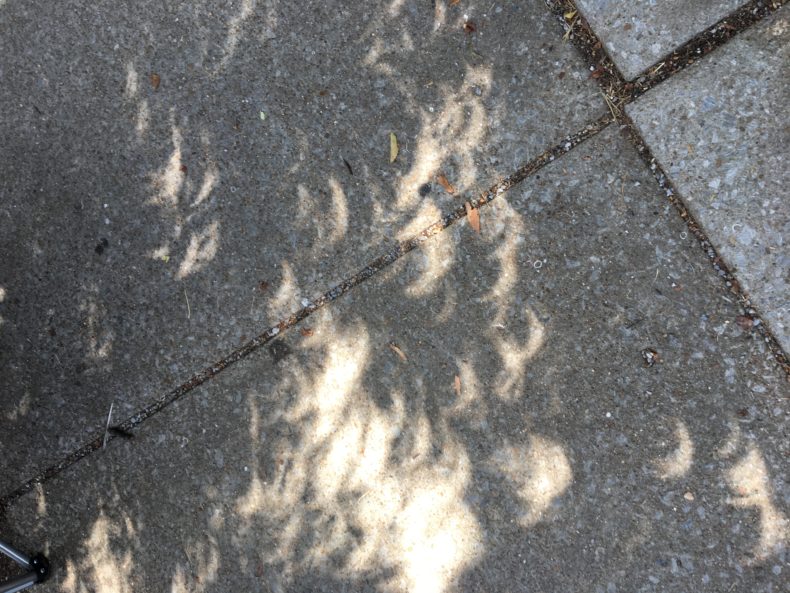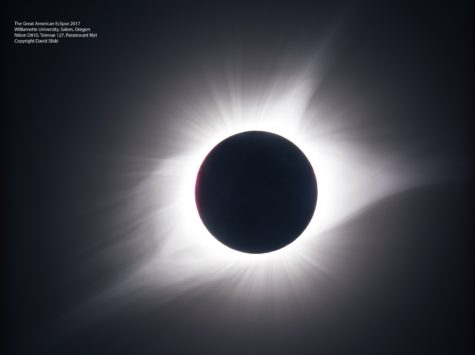In the week leading up to a rare total solar eclipse, we bring you a daily lineup of eclipse writing from the People of LWON. This piece was contributed as a guest post in 2017 by our own dear Becky, who has since joined us full time.

2017 was the year of the Great American Eclipse, and I live in its path. I also write about the Earth, moon, and sun for a living. So I was determined to not only cover the eclipse, but own it. Like many creative people, I am happiest when I am doing work for myself, and much of my job satisfaction comes from convincing (or trying to convince) other people to care about my interests as much as I do. So the eclipse was both something I wanted to experience, and something I ardently wanted Americans to experience together. But when you invest great meaning in your work, even creative work can weigh on you like freight.
I immersed myself in eclipse ephemera for months. I talked to countless people who study them and travel the world to witness them, for science and pleasure. But as the Earth turned toward the summer solstice, I realized I burdened the eclipse — and, I’ll be honest, myself — with an almost unfairly massive load. By mid-July, I worried, What if this is dull? What if my work is dull?
As eclipse day neared, I prepared to be disappointed. I thought we might miss it. The day before the eclipse, the National Weather Service called for clouds over St. Louis, where I live with my family. We decided to get up early and drive east. I slept maybe 2 hours that night. I knew I would be rising well before the sun did, and piling everyone into the car to flee for a cloudless sky. I was consumed with dread and near-certainty that it would not be worth it.
The highways leading out of St. Louis were flowing that morning, but full of cars. Every roadside hotel was booked, and every parking spot was taken. We hightailed it for Paducah, Kentucky — which sure is fun to say out loud — and some three hours later, we stopped at a chain restaurant for pancakes. It was packed with people wearing their eclipse finery: homemade or professionally designed T-shirts, Star Trek insignia, other emblems of nerddom and commemoration. People really were excited about this thing! Did I have some small part in that? I can’t know. But I felt a creeping sense of accomplishment. I started to feel less dread and more excitement, even as I kept a close eye on the sky and clouds banking on the western horizon.
Finally, we decided to settle down on a levee on the banks of the Ohio River. My toddler had a book and we all had eclipse glasses and sunscreen. I got a message from the White House: The president would be watching from a balcony. I had been wondering. I paced around, waited for “first contact,” the term for the moon’s first bite of the sun’s disk, and realized I wasn’t ready.
But the clockwork of the heavens rolls forward despite our hopes and fears. It just happened. After months of preparing and writing, I thought I knew what to expect. You know the next line.
The light continually changed as the moon edged closer to encompassing the whole sun. I took a picture of a thousand splendid crescents shimmering through foliage. About 4 minutes before totality, I looked directly at the sun (I know, I know) and I was astonished: such a small sliver remained! And somehow this crescent illuminated the whole world. Its golden hue was not quite reminiscent of dusk or dawn; it was too metallic, too saturated. My brain had a hard time processing it. The shadows were long as though it were noon, yet the sky overhead was darkening. The crescent waned ever further and the cicadas went bananas, and I knew we were a minute away. The moment was coming. The sun was going.
I looked up, waiting for the much-anticipated diamond ring effect, when the sun’s disk is blotted out save for a faint circle topped by a tiny bright spot, like an engagement ring. This happens as shafts of sunlight stream through shallows on the moon, an instant before the moon totally covers the sun. And then there it was: a miniature sun, a shaft of pure light shining alongside a halo of indescribable whiteness. I did not think of it as a ring. It did not look like a bead, or a diamond. It looked like glory, moving through space and time. I had this thought: The moon is a place, with valleys, and oh, there they are.
Then it was gone, and just the corona was left. I knew this would happen, I’d read about it a hundred times, but I was shaking and found myself in tears. All was dark, and my toddler stopped squirming in my husband’s arms and said “I not go night-night now.”
I stared at the corona and the black dot of the moon. It was the opposite of emptiness. Instead, I felt the heavy presence of the moon so strongly, more than I do even on a full moon night, my favorite night. I swear I felt the distance between me and the sun. It reached down to me, and I sensed its distance, and the power it requires to cross that distance. I saw Jupiter and Mars, my favorite planet. I sensed that I stood on a planet just like it. I looked across the river and saw a weird dawn in all directions, and orange-tinged clouds floating over indigo water.

My husband reminded me of my new binoculars, and I threw them up to my eyes. Two eclipses greeted me before I adjusted the optics, and they were both gentle. I saw a thin curve of purple, the most otherworldly tint of any color I have ever seen, real or rendered. It was the chromosphere. The sun’s surface was a friendly shade of lavender. Nothing I read or wrote before the eclipse prepared me for this.
Another breath later, that was it. Done. I watched the beads and the ring reappear, and then the corona was gone, I put down my binoculars, the cicadas shut up, and the crescent returned. The light shifted back to gold. Around me, the crowd on the Ohio riverbank high-fived, smiled, hugged. My husband and I packed up our chairs and walked back to the car, me carrying our toddler and my husband carrying everything else. We were quiet.
Driving home, I sat in the passenger seat somewhat in shock, trying to write down a few impressions that would be published later that afternoon. Then my phone started buzzing. My mom sent a picture of herself and some friends, watching the partial eclipse from Denver, wearing glasses I had sent home. A friend in St. Louis sent a photo of her toddler, looking up while wearing a paper-plate mask and eclipse glasses. My editor, watching from Oregon, wrote to make sure I saw it. Friends who had read all my stories chimed in to tell me what they witnessed, and to make sure I witnessed it, too. Millions of people shared the experience, which was exactly what I wanted.
Then we got home, had eclipse cupcakes, and went to bed. On Tuesday I turned my attention to my other deadlines, to my toddler, to the neverending assault of laundry. That was … it. Two minutes of darkness, which I’d spent months anticipating, were gone.
Recently, a couple friends asked if I would have felt this eclipse so deeply if I hadn’t spent so much of 2017 thinking and writing about it. I can’t answer that. I care about the sun, the Earth and the moon more than a lot of people, I’d argue, so I would have witnessed this eclipse no matter what, and I would have enjoyed it. The thought that I would not also write something about it, and create something, and make it my work, never occurred to me.
“The mind—the culture—has two little tools, grammar and lexicon: a decorated sand bucket and a matching shovel,” wrote Annie Dillard. “With these we bluster about the continents and do all the world’s work. With these we try to save our very lives.” So I tried.
At the outset of all this madness, I bought a notebook from Barnes & Noble, which I do every year, and which I use to collect story ideas and think through concepts. A writer’s notebook, like the act of writing itself, is both aspirational and confessional. It contains scraps of wisdom, gathered or earned, along with inevitable bits of vanity and doubt. This particular notebook is gilded with a radiant eclipsed sun, surrounded by a mosaic of ringed planets and eight-pointed stars. It’s on my desk right now. I’m still filling it with possibilities and uncertainties. It has a page that says “post-eclipse ideas.” It’s not full yet. I’m working on it.
Photo credits: Top, Rebecca Boyle; bottom, copyright David Sliski, courtesy of Jay Pasachoff